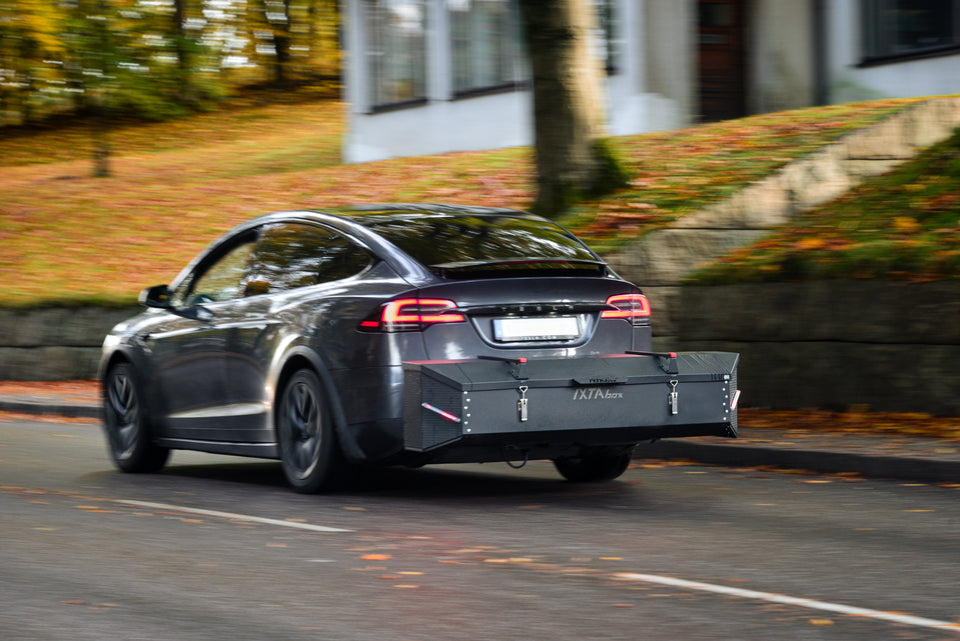Background to the Crash Tests
These were some of the key questions we at IXTAbox asked ourselves before conducting crash tests at the Swedish National Road and Transport Research Institute in Linköping (VTI):
- How well does an IXTAbox perform in a crash situation?
- What can a heavily loaded IXTAbox withstand in a crash?
- What happens during a crash? – Does it detach from the towbar? – Does the lid open?
- What happens to items loaded on the lid?
- How does an IXTAbox compare to a branded roof box on the market?
- How severe a crash can an IXTAbox endure compared to other tested products?
- What requirements are placed on a rear-mounted cargo box from a crash perspective?
- What other requirements must be met for a rear-mounted box to be sold?
During autumn 2024 and early 2025, Prodelox AB carried out consultancy work commissioned by and in collaboration with IXTAbox to understand any regulatory requirements or standards that apply to rear-mounted boxes.
The study concluded that there are no mandatory requirements or specific standards (including crash standards) for this type of product, except for lighting requirements and possibly ECE R 26 regulations regarding sharp edges and risks of protruding parts that could catch on vulnerable road users.
Transportstyrelsen (the Swedish Transport Agency) asked VTI to assess the IXTAbox's compliance with ECE R 26 regulations. VTI confirmed there were no accessible sharp edges or hazardous protruding parts. VTI considers the IXTAbox to meet all ECE R 26 requirements. However, IXTAbox has not yet formally applied for certification.
Armed with this knowledge, we engaged in discussions with knowledgeable staff at VTI to design an appropriate series of crash tests, aiming to verify the product's function and safety based on well-established crash test standards.
To validate IXTAbox and answer the above questions, six crash tests were conducted in total: five on IXTAbox and one reference test on a roof box. The crash test on IXTAbox was performed on February 25, 2025.
Conditions for the Crash Tests
The maximum legal nose load for a trailer is usually 100 kg. The tested IXTAbox weighed 34 kg, meaning the box could theoretically be filled with 66 kg of load. Instead, it was filled with 75 kg of lumber, fibreboards, and ski equipment — a slight but deliberate overload. The shape of the boards ensured even weight distribution across the width of the IXTAbox.
CRASH TEST 1
Test method used: Standard for roof loads/roof boxes SS-ISO 11154:2023
This test involves a crash at 16 km/h (tolerance: -0 / +2 km/h) with an acceleration of over 8 g for at least 30 ms. A maximum of 10 grams of load or components may come loose.
- Speed: 16.89 km/h
- Duration over 8 g: 34.24 ms
- Peak g-force: 9.27 g
Crash Test 1 Gallery
Curve showing acceleration during test 2025-02-25—1. Images show the IXTAbox mounted on the towbar with test load, and the condition of the box after the crash test.

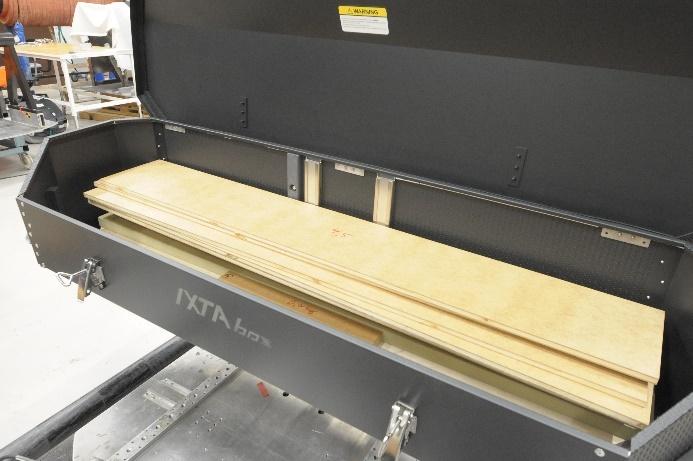
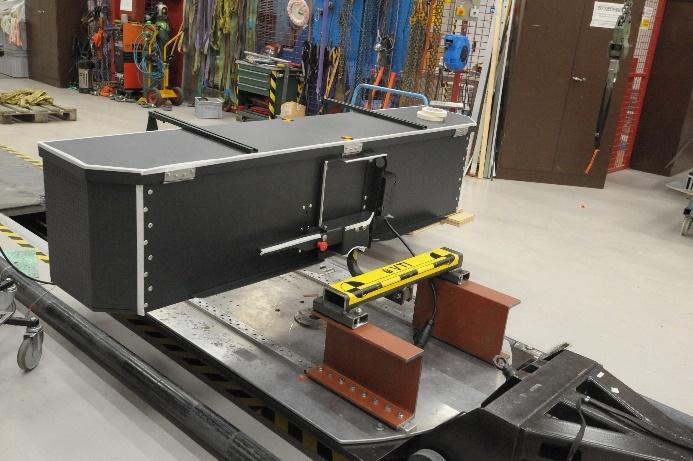
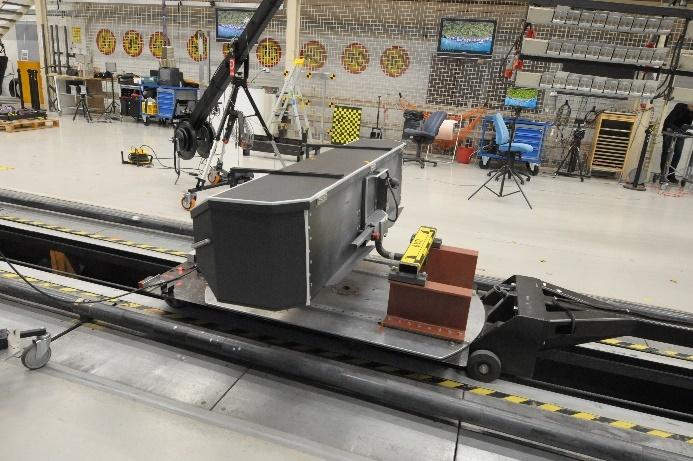
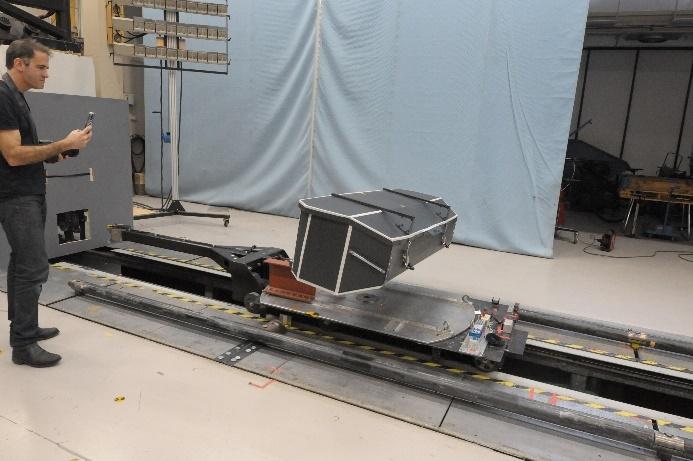
Test 1 Results
No parts came loose. The box remained intact. Only a minor angular shift at the towbar attachment was noted.
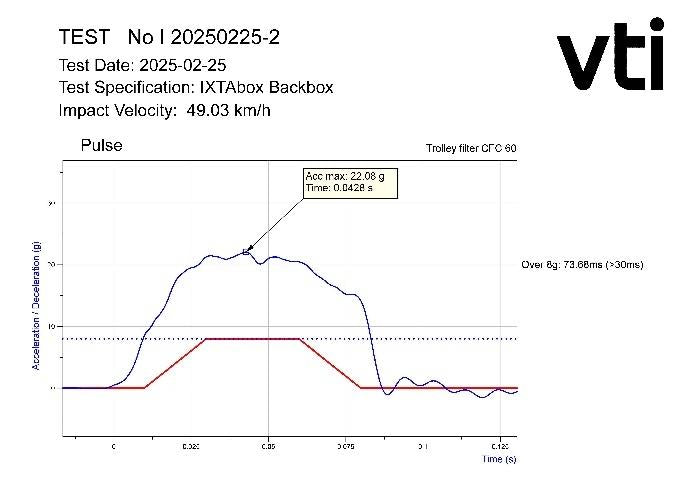
CRASH TEST 2
Based on the results of Test 1, the next test used a more intense crash pulse, similar to those for child car seats (standards like ECE R 17 and ECE R 129):
- Speed: 49 km/h (50 km/h tolerance: -2 / +0 km/h)
- Deceleration distance: 550–600 mm
- Goal: exceed 20 g for at least 15 ms
- Peak g-force: 22 g
Test 2 Results
Over 20 g for ~34 ms. IXTAbox remained intact, with only slight forward tilting. No load was released.
Crash Test 3
Now testing with the "Plus pulse", a harsher crash used for child car seats to receive a “plus” certification. While these standards aren’t directly applicable to cargo boxes, the high stress is useful for consumer-level validation. It should be emphasised here that it is also about getting low values for the load in the child crash dummy that is used. Therefore, it is not possible to directly translate the extensive requirements for a child car seat into requirements for a load box.
- Speed: 56 km/h
- Deceleration: 470–490 mm
- Peak g-force: 33.4 g
- Over 30 g for more than 30 ms (4x higher than ISO 11154:2023)
Crash Test 3 Gallery
Curve showing acceleration during test 2025-02-25—3. Images show the deformation caused during the test.

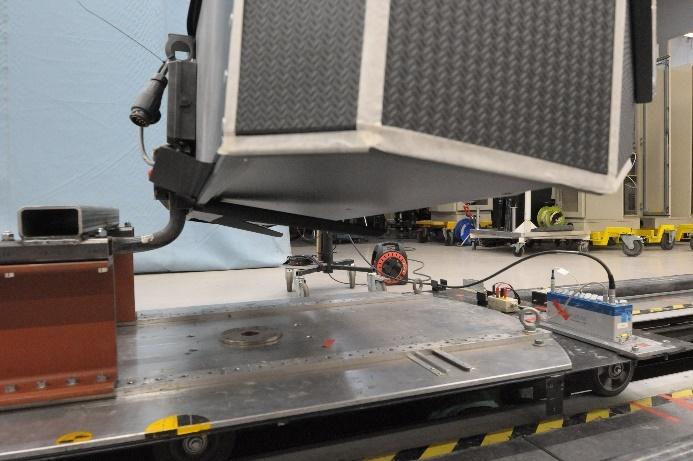
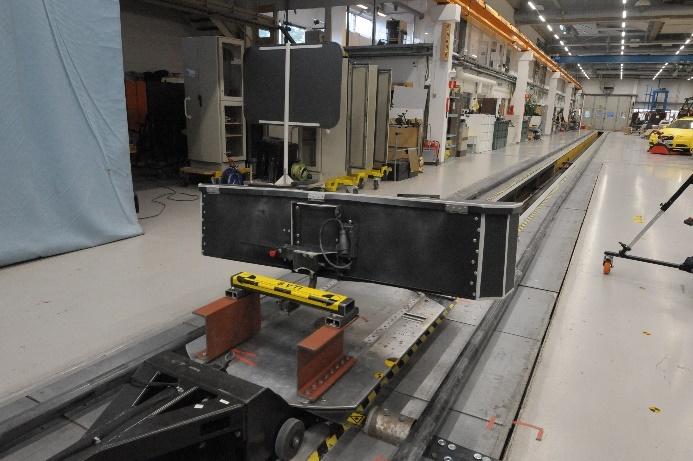
Test 3 Results
It’s worth noting that the same box was used in Tests 1 and 2, and in Test 3, the IXTAbox sustained some damage. Some rivets at the bottom of the IXTAbox came loose. Minor lid deformation. No parts or load were ejected.
The box still formally met the standard of no object over 10 grams detaching.
Crash Test 4
Due to partial damage in Test 3, a new IXTAbox was used.
- A woman's bicycle and rack (approx. 23 kg) were mounted on the box lid.
- The internal load was adjusted to 52 kg.
- Test followed ISO 11154 at 17 km/h and approx. 8–10 g.
Crash Test 4 Gallery
Curve showing acceleration during test 2025-02-25—4. IXTAbox before test, loaded with bike and bike rack.
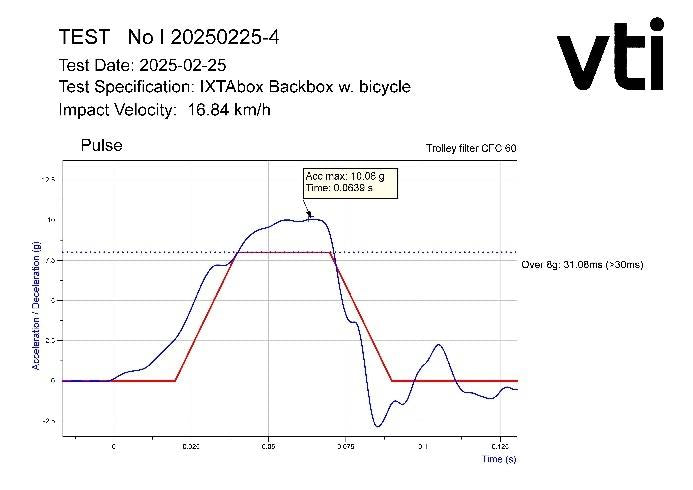
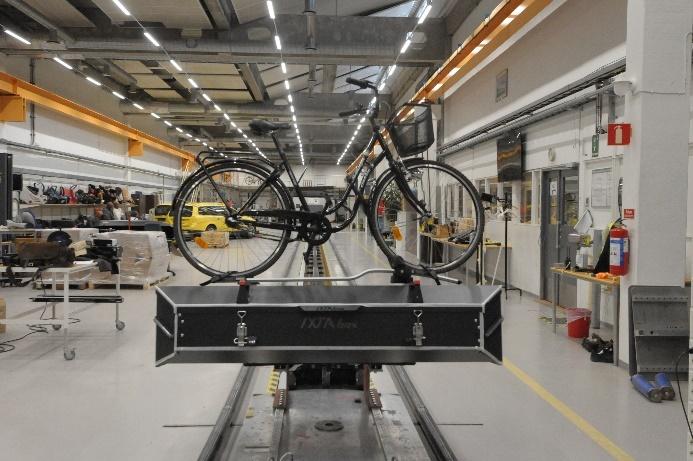
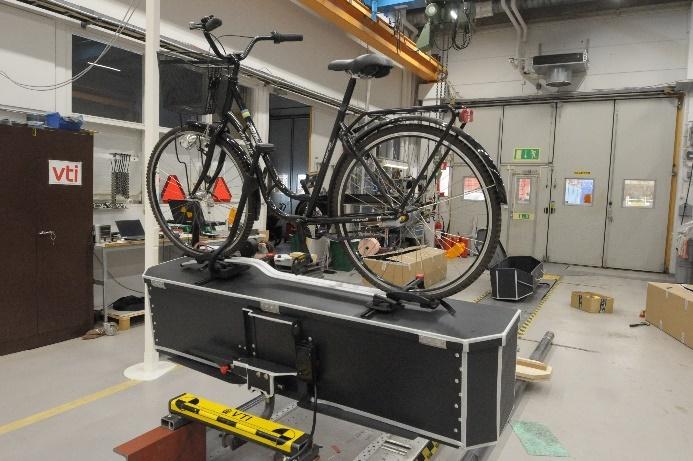
Test 4 Results
The higher centre of gravity caused the bike to lurch forward slightly. One of the rails cracked slightly, but nothing detached.
The ISO requirement was still met.
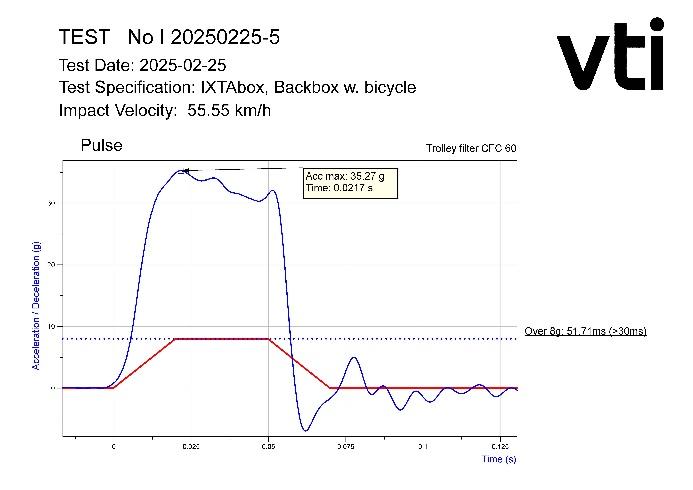
CRASH TEST 5
The most extreme scenario: Plus pulse with the 23 kg bike on top and 52 kg inside.
- The box from Test 4 was repaired (only the rail was replaced).
- Speed: 56 km/h
- Deceleration: 470–490 mm
- Peak g-force: 35.3 g, with over 30 g for 39 ms
Test 5 Results
The bike remained attached but tilted more, and there was a larger separation at the box bottom, with some rivets shearing. No contents escaped. The IXTAbox stayed attached to the towbar (which was deformed).
A tough test, but the box performed impressively.
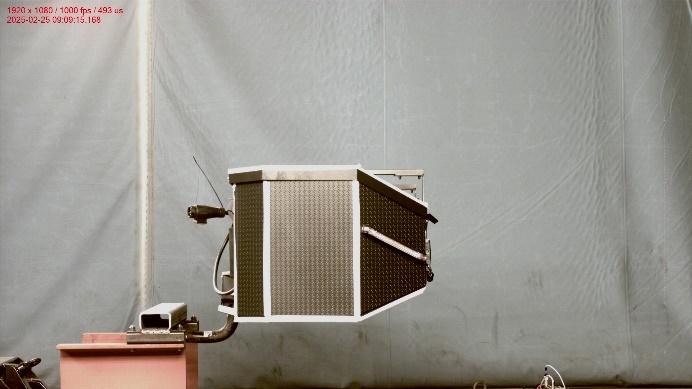
Summary of the First 5 Crash Tests
IXTAbox exceeds the ISO 11154:2023 requirements, even when:
- Loaded with 75 kg
- Carrying a bike on top
- Subjected to crash pulses far beyond what's required of roof boxes
The results suggest IXTAbox may meet or surpass any future rear box crash standards.
Construction using aluminium and stainless steel effectively absorbs crash energy, preventing both detachment from the towbar and release of the load.
Crash Test 6 – Roof Box Reference Test
Goal: Test how a regular roof box from a leading brand handles the same Plus pulse (56 km/h, ~33–35 g)
- A 75 kg loaded roof box was mounted on a branded roof rack, on simulated roof rails made by VTI.
- The roof rack was assembled using a torque-limiting tool set to 4 Nm.
Results
A mishap, the roof rack slid on the rails, leading to:
- The roof box moving forward into the brake barrier
- The box opening and partially ejecting its contents
This compromised the test, as the result reflects more on the roof rack’s limitations than the box itself.
VTI noted that it's likely no typical roof rack can withstand such extreme deceleration. There is a significant risk that roof boxes could detach completely and eject their contents like projectiles in a real-world crash at these speeds.
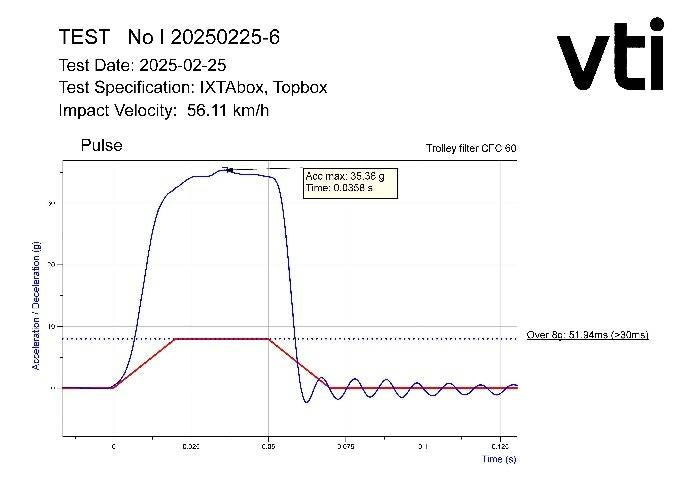
Curve showing acceleration during test 2025-02-25—6.
VTI noted that it's likely no typical roof rack can withstand such extreme deceleration.
There is a significant risk that roof boxes could detach completely and eject their contents like projectiles in a real-world crash at these speeds.
Overall Conclusions from the Crash Tests
VTI’s Evaluation
The IXTAbox has been tested and evaluated using applicable portions of ISO 11154:2023, ECE R 17, ECE R 129, and ECE R 26. As IXTAbox is neither a roof load carrier nor a vehicle, it cannot be formally "approved" under those methods, but it meets or exceeds all thresholds and test procedures applied.
Our Reflections at IXTAbox
We’re proud that IXTAbox passed the tests so well. We sleep soundly knowing it’s likely one of the safest transport solutions for passenger cars on the market.
We’re also surprised and somewhat concerned that formal requirements for roof boxes are set so low. Expecting them to withstand only a 17 km/h crash feels insufficient, especially considering most people drive well over 50 km/h when heading to or from mountain trips.
